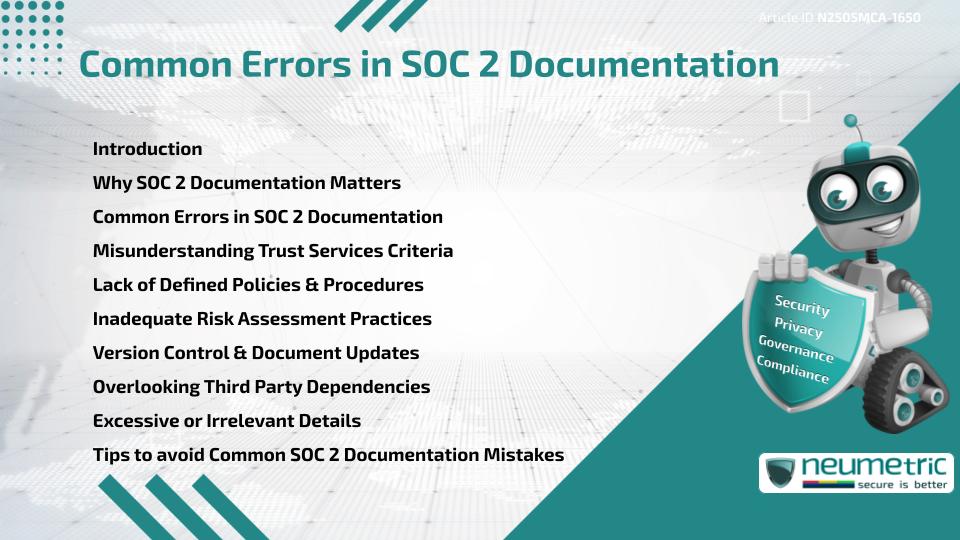Table of Contents
ToggleIntroduction
SOC 2 Compliance is vital for any Service Organisation aiming to build Customer Trust. However, many businesses struggle with the quality & accuracy of their documentation. The common errors in SOC 2 documentation can delay Audits, create Gaps in Compliance & damage Client confidence. This article explores the most frequent issues, why they occur & how to avoid them with practical solutions.
Why SOC 2 Documentation Matters
SOC 2 reports, governed by the American Institute of Certified Public Accountants [AICPA], evaluate an Organisation’s controls over Data Security, Availability, Processing Integrity, Confidentiality & Privacy. Documentation supports these evaluations by showing Policies, practices & evidence of Control implementation.
Poor documentation doesn’t just reflect negligence—it may suggest that systems are either mismanaged or non-compliant. Accurate records are also critical in case of external review or legal inquiry.
Common Errors in SOC 2 Documentation
Several pitfalls routinely show up during SOC 2 Assessments. Understanding these common errors in SOC 2 documentation can help prevent failed Audits & ensure smoother Certification.
Misunderstanding Trust Services Criteria
The five (5) Trust Services Criteria—Security, Availability, Processing Integrity, Confidentiality & Privacy form the foundation of SOC 2. Misinterpreting these can lead to irrelevant or incomplete documentation.
For example, focusing only on Security & ignoring Availability might result in missing controls like Disaster Recovery. Each Organisation must tailor its documentation to its chosen criteria.
Lack of Defined Policies & Procedures
A frequent issue in SOC 2 documentation is vague or missing Policy definitions. Many companies rely on informal processes or tribal knowledge without writing them down.
Policies around Access Control, Encryption or Incident Response must be clearly documented, versioned & reviewed regularly. Ambiguity raises Auditor concerns & weakens your security posture.
Inadequate Risk Assessment Practices
Another of the common errors in SOC 2 documentation is poorly defined Risk Assessments. These Assessments should not be generic; they must reflect actual Threats & mitigation plans relevant to your systems & business model.
Failing to include Threat Scenarios, Control Gaps & mitigation timelines weakens the credibility of your documentation. NIST’s Risk Assessment process provides a robust Framework.
Version Control & Document Updates
Organisations often forget to version-control their Policies or track updates. Without clear documentation history, it becomes hard to prove when a policy was implemented or how it evolved.
Using Change Logs or Document Management Tools helps ensure traceability. Missing update records is one of the most easily avoidable common errors in SOC 2 documentation.
Overlooking Third Party Dependencies
SOC 2 documentation should cover more than internal Controls. If your systems depend on Third Party Services—like Cloud Providers or Payment Gateways, then their Controls also become part of your Compliance story.
Failing to document how you evaluate or monitor Third Party Vendors is a major oversight. The Shared Responsibility Model from AWS offers useful clarity on this.
Excessive or Irrelevant Details
Trying to impress Auditors by overloading documentation can backfire. Excessive details often distract from what matters & irrelevant content makes it harder to verify real controls.
SOC 2 documentation should be focused, structured & aligned to the control objectives. Clarity beats volume every time.
Tips to avoid Common SOC 2 Documentation Mistakes
Avoiding the common errors in SOC 2 documentation is about structure, awareness & discipline. Here are a few helpful tips:
- Use templates based on Industry Standards such as ISACA’s documentation frameworks.
- Regularly Audit & update your documentation.
- Assign clear ownership for each document.
- Involve cross-functional teams for accuracy.
- Align documentation directly with your SOC 2 scope & controls.
Takeaways
- SOC 2 documentation serves as a fundamental element of your compliance rather than merely a procedural requirement.
- Misunderstanding Trust Services Criteria or omitting Policies is risky.
- Documentation must be accurate, current & tied to real business processes.
- Avoid irrelevant data & focus on clear, well-maintained evidence.
- Treat your documentation like living records, not one-time checklists.
FAQ
What is the most overlooked area in SOC 2 documentation?
Many Organisations overlook Third Party Risk documentation, failing to address Vendor responsibilities & their Compliance impact.
Why is version control important in SOC 2 documentation?
It helps Auditors track updates, prove Compliance timelines & maintain consistency across policy updates & audits.
Can excessive documentation be a problem?
Yes, too much or unfocused documentation can overwhelm Auditors & hide important details. Relevance & clarity are key.
What is a common error in Risk Assessment documentation?
Generic Risk Assessments that do not reflect your business or systems accurately are a frequent & serious mistake.
How do missing Policies affect SOC 2 Compliance?
Missing Policies suggest inadequate controls & create evidence gaps that can result in Audit delays or failures.
Is automation useful in preventing common SOC 2 documentation errors?
Yes, using Compliance Automation Tools can reduce manual errors & maintain updated & accurate documentation.
What happens if documentation does not align with actual practices?
This is a red flag for Auditors. Mismatches between documents & operations indicate poor internal Governance.
Are templates recommended for SOC 2 documentation?
Yes, as long as they are customised to your actual systems & not used as generic fillers without real applicability.
Should documentation be centralised?
Absolutely. A centralised document repository improves consistency, access & control during SOC 2 audits.
References
Need help?
Neumetric provides organisations the necessary help to achieve their Cybersecurity, Compliance, Governance, Privacy, Certifications & Pentesting goals.
Organisations & Businesses, specifically those which provide SaaS & AI Solutions, usually need a Cybersecurity Partner for meeting & maintaining the ongoing Security & Privacy needs & requirements of their Clients & Customers.
SOC 2, ISO 27001, ISO 42001, NIST, HIPAA, HECVAT, EU GDPR are some of the Frameworks that are served by Fusion – a centralised, automated, AI-enabled SaaS Solution created & managed by Neumetric.
Reach out to us!


